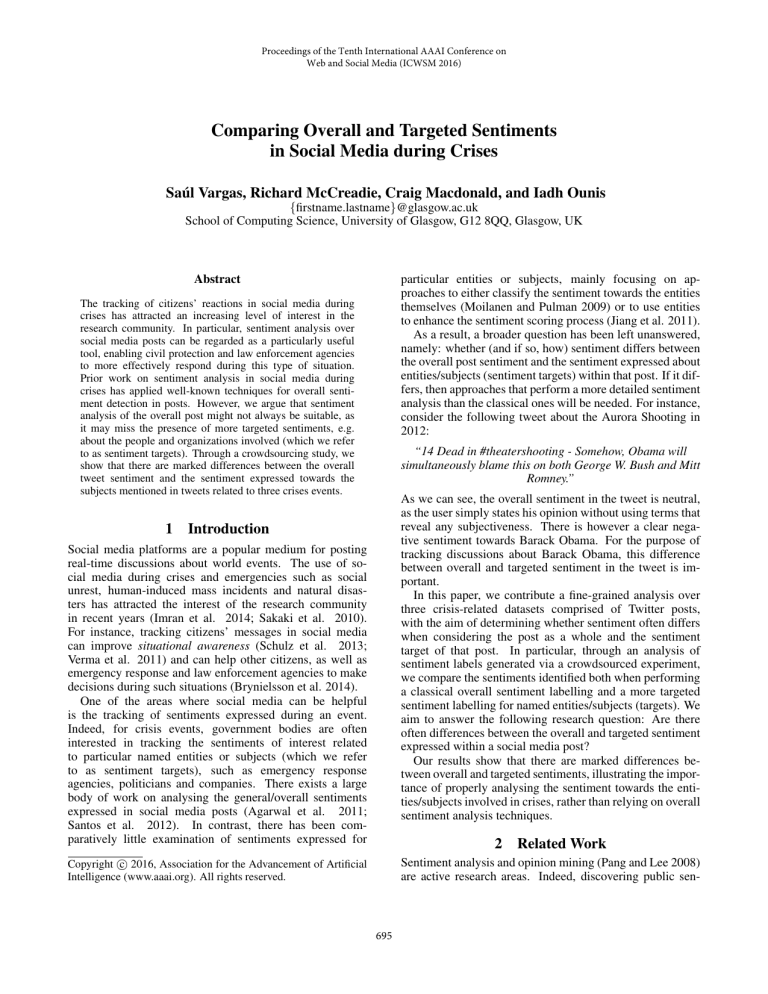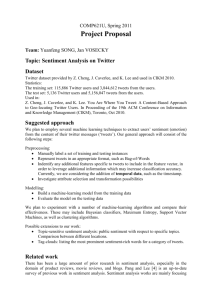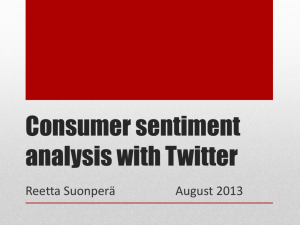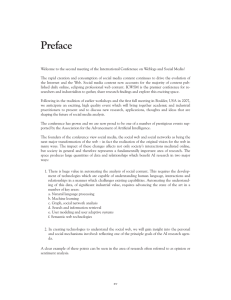
Proceedings of the Tenth International AAAI Conference on
Web and Social Media (ICWSM 2016)
Comparing Overall and Targeted Sentiments
in Social Media during Crises
Saúl Vargas, Richard McCreadie, Craig Macdonald, and Iadh Ounis
{firstname.lastname}@glasgow.ac.uk
School of Computing Science, University of Glasgow, G12 8QQ, Glasgow, UK
particular entities or subjects, mainly focusing on approaches to either classify the sentiment towards the entities
themselves (Moilanen and Pulman 2009) or to use entities
to enhance the sentiment scoring process (Jiang et al. 2011).
As a result, a broader question has been left unanswered,
namely: whether (and if so, how) sentiment differs between
the overall post sentiment and the sentiment expressed about
entities/subjects (sentiment targets) within that post. If it differs, then approaches that perform a more detailed sentiment
analysis than the classical ones will be needed. For instance,
consider the following tweet about the Aurora Shooting in
2012:
Abstract
The tracking of citizens’ reactions in social media during
crises has attracted an increasing level of interest in the
research community. In particular, sentiment analysis over
social media posts can be regarded as a particularly useful
tool, enabling civil protection and law enforcement agencies
to more effectively respond during this type of situation.
Prior work on sentiment analysis in social media during
crises has applied well-known techniques for overall sentiment detection in posts. However, we argue that sentiment
analysis of the overall post might not always be suitable, as
it may miss the presence of more targeted sentiments, e.g.
about the people and organizations involved (which we refer
to as sentiment targets). Through a crowdsourcing study, we
show that there are marked differences between the overall
tweet sentiment and the sentiment expressed towards the
subjects mentioned in tweets related to three crises events.
1
“14 Dead in #theatershooting - Somehow, Obama will
simultaneously blame this on both George W. Bush and Mitt
Romney.”
As we can see, the overall sentiment in the tweet is neutral,
as the user simply states his opinion without using terms that
reveal any subjectiveness. There is however a clear negative sentiment towards Barack Obama. For the purpose of
tracking discussions about Barack Obama, this difference
between overall and targeted sentiment in the tweet is important.
In this paper, we contribute a fine-grained analysis over
three crisis-related datasets comprised of Twitter posts,
with the aim of determining whether sentiment often differs
when considering the post as a whole and the sentiment
target of that post. In particular, through an analysis of
sentiment labels generated via a crowdsourced experiment,
we compare the sentiments identified both when performing
a classical overall sentiment labelling and a more targeted
sentiment labelling for named entities/subjects (targets). We
aim to answer the following research question: Are there
often differences between the overall and targeted sentiment
expressed within a social media post?
Our results show that there are marked differences between overall and targeted sentiments, illustrating the importance of properly analysing the sentiment towards the entities/subjects involved in crises, rather than relying on overall
sentiment analysis techniques.
Introduction
Social media platforms are a popular medium for posting
real-time discussions about world events. The use of social media during crises and emergencies such as social
unrest, human-induced mass incidents and natural disasters has attracted the interest of the research community
in recent years (Imran et al. 2014; Sakaki et al. 2010).
For instance, tracking citizens’ messages in social media
can improve situational awareness (Schulz et al. 2013;
Verma et al. 2011) and can help other citizens, as well as
emergency response and law enforcement agencies to make
decisions during such situations (Brynielsson et al. 2014).
One of the areas where social media can be helpful
is the tracking of sentiments expressed during an event.
Indeed, for crisis events, government bodies are often
interested in tracking the sentiments of interest related
to particular named entities or subjects (which we refer
to as sentiment targets), such as emergency response
agencies, politicians and companies. There exists a large
body of work on analysing the general/overall sentiments
expressed in social media posts (Agarwal et al. 2011;
Santos et al. 2012). In contrast, there has been comparatively little examination of sentiments expressed for
2
c 2016, Association for the Advancement of Artificial
Copyright Intelligence (www.aaai.org). All rights reserved.
Related Work
Sentiment analysis and opinion mining (Pang and Lee 2008)
are active research areas. Indeed, discovering public sen-
695
Event
Country
Language
#Tweets
Start date
End date
USA
USA
Spain
English
English
Spanish
151,046
238,165
123,872
20/07/12
28/08/12
26/02/15
30/07/12
07/09/12
09/03/15
Aurora Shooting
Hurricane Isaac
Ebro Flood
Table 1: Crisis-related datasets and their statistics.
timents and opinions is of great value in various fields
such as reputation monitoring, marketing, recommendation
and emergency management. For these different fields,
sentiment analysis has been applied to a variety of textual sources, such as blogs (He et al. 2008), hotel reviews (Marcheggiani et al. 2014) and, more relevant to our
case, social media posts such as tweets (Agarwal et al. 2011;
Barbosa and Feng 2010; Jiang et al. 2011).
Notably, while most of the reviewed work on sentiment
analysis focuses on estimating the overall sentiment of
a text, some prior works have proposed a more detailed
analysis of the sentiments within subsets of that text.
For instance, Moilanen and Pullman (2009) consider the
sentiment towards named entities appearing in documents.
Meanwhile, Marcheggiani et al. (2014) examined aspectorientated opinion (sentiment) mining for pre-defined
information aspects (e.g. cleanliness, location, food) within
hotel reviews. Similarly, Jiang et al. (2011) considered an
approach for enhancing this sentiment classification by considering features about named entities. However, none of
these works address the question of whether within a social
media post, there is often a difference between the overall
sentiment of a post and the sentiment expressed about the
targets (entities/subjects) of that post. In this paper, we
analyse and quantify the differences between overall and
targeted sentiments over the key subjects involved in three
different crisis events as reflected on Twitter. Furthermore,
we show through experimentation the extent to which
supervised sentiment classification techniques such as those
used in the aforementioned works can be tailored to targeted
sentiment classification.
3
Event
Sentiment Targets
Aurora Shooting
Aurora PD, Christian Bale, DC-Comics, FBI, James
Holmes, Christopher Nolan, Barack Obama, Mitt Romney, Warner Bros
2,184
Hurricane Isaac
Army Corps of Engineers, B. Jindal, Nat. Guard, B.
Obama, P. Bryant, Red Cross, R. Scott, R. Bentley, M.
Romney
2,085
Ebro Flood
Aragonese Gov., Ebro Hydrographic Conf., Civil
Guard, Civil Protection, Firemen, Police, M. Rajoy,
Red Cross, L. F. Rudi, Spanish Gov., I. Garcı́a Tejerina,
Military Emergencies Unit
2,089
#Tweets
Table 2: Sentiment targets selected for each event and number of tweets mentioning them.
to filter the Hurrican Issac dataset. For the 2015 dataset,
similar types of keywords/phrases were used to collect a live
tweet stream during the event, using the Twitter Streaming
API. For all three datasets, the keywords used were defined
by human annotators who were native speakers of the primary language of each event (English/Spanish).
Subject selection and filtering For these three datasets, we
have manually selected lists of sentiment targets/subjects
among the political figures, institutions, companies and
celebrities that were involved in these events. These sentiment targets were selected based on the associated coverage of each event in news articles and on Wikipedia. We
then automatically filtered the tweets from each event to include only those that made reference to the selected targets.
To improve the accuracy of the filtering process, we considered multiple ways that a user might refer to each subject
(e.g. Barack Obama, Obama, the president, POTUS) as well
as Twitter handles (such as @BarackObama, @POTUS) to
determine the presence of the sentiment targets within the
tweets. The sentiment targets and the number of related
tweets labelled for each event are listed in Table 2.
Sentiment labelling For the resulting tweets mentioning the
selected subjects, we conducted two crowdsourced sentiment labelling tasks. In the first task, crowdsourced workers
were asked to label a tweet according to the sentiment that
the author of the tweet expresses: negative (anger, disgust,
sadness, surprise, hatred, etc.), neutral (statements) or positive (happiness, gratitude, joy, love, pride, etc.). In the second task, a tweet and subject pair was given, and the worker
is tasked with labelling the tweet as containing a negative,
neutral or positive sentiment by the author of the tweet with
respect to the given subject. For each of these tasks, three
different crowd workers labelled each tweet or tweet and
subject pair.
Crowdsourcing Configuration For all crowdsourcing labelling tasks, we use the CrowdFlower crowdsourcing platform. The unit of assessment is a single page, which contains 5 tweets. For the US-based events, we restricted the geographical regions that could participate to only the United
States, whereas for the Ebro Flood event, only Spanishspeaking workers were used. For both labelling tasks, we
paid US $0.07 for each page of 5 tweets. The number
of tweets a single worker could label was limited to 200.
Worker quality was dynamically assessed against a gold
standard set of 100 tweets per experiment labelled by the
authors. Workers whose accuracy on these gold standard
Experimental Setup
Datasets To evaluate the differences between overall and
targeted sentiments we use three tweet datasets crawled
via the Twitter Streaming API.1 Each of these three tweet
datasets relate to different crisis-related events, namely the
Aurora Shooting (2012), the Hurricane Isaac (2012) and the
Ebro River Flood (2015). These datasets cover two different types of crises, human-induced and natural disasters,
and two languages, English and Spanish. Table 1 provides
salient statistics about the three datasets. For the two 2012
events, a random tweet sample (approximately 1% of the total the full Twitter stream) was collected during the time period of these events. These tweets were then filtered based
on a set of keywords/phrases2 to remove posts that do not
discuss the two events. For example, terms/phrases such as
“#Isaac”, “Red Cross” and “Plaquemines Parish” were used
1
https://dev.twitter.com/streaming/overview
Hashtags, names of people, organisations or locations associated to each event.
2
696
Sent.
#w
a≥2
a=3
Fleiss’ κ
Aurora Shooting
overall
targeted
129
53
99.3%
99.7%
73.1%
77.8%
0.513
0.519
Hurricane Isaac
overall
targeted
53
56
99.4%
98.4%
69.3%
69.4%
0.315
0.330
Ebro Flood
overall
targeted
252
191
99.1%
99.2%
63.4%
64.2%
0.387
0.377
Event
Table 3: Statistics of the crowsourced experiment.
In turn, the joint distribution of sentiments is computed as
the aggregate probability of each tweet being assigned to a
pair of sentiments in the two tasks (e.g. the probability that
a tweet had an overall sentiment of neutral but a targeted
sentiment of positive):
tweets dropped below 70% were ejected from the experiment.
Worker Agreement The statistics of the workers and their
agreement are shown in Table 3. From the table, we observe
that the number of workers (#w) was high: above fifty over
all tasks. Moreover, the percentage of tweets for which at
least two (out of three) users agree (a ≥ 2), is above 98%,
which indicates that there is little or no randomness in the
answers given by the crowdsourced workers. We also see
that the total agreement (a = 3) is reasonably high (≥ 63%).
Finally, the Fleiss’ κ measure provides a statistical confirmation of the degree of agreement between several workers for
each task, showing that we obtain fair (∼ 0.3) to moderate
(∼ 0.5) agreement measurements. In general, these results
indicate that the described crowdsourcing configuration produces good quality sentiment labels.
Reproducibility The filtered dataset described above, as
well as the associated crowdsourced labels used for evaluation are available as a free download:3
c(st , so ) =
4
(1)
where Lt is the number of labels assigned to the tweet t
(Lt ≥ 3) and Lt,s the number of labels for tweet t that correspond to sentiment s ∈ {neg, neu, pos}. Differences between the two sentiment labelling tasks (overall vs. targeted)
are then measured by means of the comparison between
the individual distributions of sentiments in each experiment
and an analysis of the joint distribution of sentiments in both
tasks. The individual distribution of each sentiment space is
calculated as the aggregate probability of each tweet being
assigned to each sentiment class:
t∈T p(s|t)
p(so |t)
(3)
Experimental Evaluation
We now describe the results of our experiment that aim to
answer whether there is a difference between overall and
targeted sentiments in tweets. Table 4 reports the individual
c(so ), c(st ) and joint c(st , so ) distributions of the overall
so and targeted st sentiment spaces in the three collected
datasets. The inner portions of the table for each dataset
report the joint distribution c(so , st ) for the sentiment
classes between the two tasks, i.e. to what extent the
sentiment changes on a per class basis. The final rows and
columns for each dataset report the individual distributions
c(so ) and c(st ) of the sentiment classes of the two tasks, i.e.
how often each sentiment class occurs in the dataset.
When considering the differences between overall and targeted individual sentiment distributions for each individual
dataset (i.e. c(so ) and c(st )), we see important differences
between overall and targeted sentiments within the tweets.
For example, Table 4 shows that the overall sentiments are
markedly more negative than the targeted ones (192.2 vs.
106.3) for the Aurora Shooting event. This already indicates
a mismatch between the presence of overall sentiment in
tweets and targeted sentiments towards the subjects in those
tweets. That same pattern repeated in the other two datasets,
although the magnitude of the difference between the overall
and targeted sentiments is smaller. This result answers our
research question, i.e. there is indeed a difference between
overall and targeted sentiment within various types of crisis
events.
However, it is also important to investigate where precisely sentiment tends to differ between the overall and targeted scenarios. To do so, we next examine the joint distribution scores c(st , so ) for the individual class pairs. First,
when comparing the proportion of tweets that remain in the
same sentiment class in both labelling tasks (the values in
bold of Table 4), we see that these numbers are small for
the negative and positive sentiments with respect to the total
Metrics In order to report the differences between the sentiments identified from the two labelling tasks (overall sentiment labelling and subject targeted labelling) within a single
metric, we report the conditional distribution of sentiment
labels assigned to each tweet:
c(s) =
t∈T p(st |t)
so /st denote overall/targeted sentiments, respectively.
http://dx.doi.org/10.5525/gla.researchdata.286
p(s|t) = Lt,s /Lt
(2)
3
Only unique tweet identifier’s are provided due to Twitter’s
ToS, however, tweet texts can be recovered for named ids using
publicly available tools (McCreadie et al. 2012)
697
st
c(st , so )
neg
neu
pos
c(so )
neg
42.9
141.4
7.9
192.2
Aurora Shooting
so
c(st )
neu
pos
106.3
61.3
2.2
1,557.0 89.0 1,787.3
290.3
78.7
203.7
1,696.9 294.9 2,184.0
neg
115.9
176.5
7.1
299.5
Hurricane Isaac
so
c(st )
neu
pos
156.6
276.3
3.9
1,493.7 44.0 1,714.2
94.5
65.0
22.4
1,715.3 70.3 2,085.0
neg
222.3
219.5
6.3
447.1
Ebro Flood
so
neu
pos
196.4
7.0
1,312.8 44.0
40.4
40.2
1,549.7 91.3
c(st )
425.7
1,576.3
87.0
2,089.0
Table 4: Individual c(st ), c(so ) and joint c(st , so ) distributions of sentiments.
number of overall and targeted negative and positive sentiments. For instance, the negative-negative pair (tweets that
were labelled as containing negative targeted and overall
sentiment) in the Aurora Shooting dataset receives a score of
42.9. Contrast this score to the total overall and targeted negative sentiment scores for the event (192.2 and 106.3 respectively). We observe the same pattern when considering the
positive class as well – the positive-positive pair received a
score of 203.7, while the overall and targeted total scores are
294.9 and 290.3, respectively, which indicates that a large
number of tweets were labelled differently under the overall
and targeted sentiment labelling scenarios. Furthermore, we
observe a recurrent pattern between tweets being labelled as
having an overall neutral sentiment but also being labelled as
having a targeted positive/negative sentiment. For instance,
for the Aurora Shooting event, we observe that the neutralnegative pair has a score of 61.3, while the neutral-positive
pair has a score of 78.7. Finally, we see that the crossover between negative and positive classes is rare, i.e. the scores for
the positive-negative and negative-positive pairs are low. Indeed, we see the same pattern across all three of the datasets.
These observations reveal that, frequently, tweets expressing
a polarised sentiment do not target all the subjects in it and,
on the contrary, tweets written in a somewhat neutral language may actually contain a negative or positive sentiment
towards a particular subject.
5
L. Barbosa and J. Feng Robust sentiment detection on Twitter from biased and noisy data. In Proc. of COLING, 2010.
J. Brynielsson, F. Johansson, C. Jonsson, and A. Westling.
Emotion classification of social media posts for estimating
people’s reactions to communicated alert messages during
crises. Security Informatics, 3(1), 2014.
B. He, C. Macdonald, J. He, and I. Ounis. An effective statistical approach to blog post opinion retrieval. In Proc. of
CIKM, 2008.
M. Imran, C. Castillo, F. Diaz, and S. Vieweg. Processing
social media messages in mass emergency: A survey. CoRR,
abs/1407.7071, 2014.
L. Jiang, M. Yu, M. Zhou, X. Liu, and T. Zhao. Targetdependent Twitter sentiment classification. In Proc. of HLT,
2011.
D. Marcheggiani, O. Täckström, A. Esuli, and F. Sebastiani. Hierarchical multi-label conditional random fields for
aspect-oriented opinion mining. In Proc. of ECIR, 2014.
R. McCreadie, I. Soboroff, J. Lin, C. Macdonald, I. Ounis
and D. McCullough. On Building a Reusable Twitter Corpus. In Proc. of SIGIR, 2012.
K. Moilanen and S. Pulman. Multi-entity sentiment scoring.
In Proc. of RANLP, 2009.
B. Pang and L. Lee. Opinion mining and sentiment analysis. Foundations and Trends in Information Retrieval, 2(12), 2008.
T. Sakaki, M. Okazaki, and Y. Matsuo. Earthquake shakes
Twitter users: Real-time event detection by social sensors.
In Proc. of WWW, 2010.
A. Schulz, T. D. Thanh, H. Paulheim, and I. Schweizer. A
fine-grained sentiment analysis approach for detecting crisis
related microposts. In Proc. of ISCRAM, 2013.
R. L.T. Santos, C. Macdonald, R. McCreadie, I. Ounis and I.
Soboroff. Information Retrieval on the Blogosphere. Foundations and Trends in Information Retrieval Journal, 6(1),
2012.
S. Verma, S. Vieweg, W. J. Corvey, L. Palen, J. H. Martin, M. Palmer, A. Schram, and K. M. Anderson. Natural language processing to the rescue? Extracting “situational awarenes” tweets during mass emergency. In Proc.
of ICWSM, 2011.
Conclusions
In this paper, we have analysed the differences between the
overall and targeted sentiment analysis of social media posts
related to three crises events. Through an experiment over
three tweet datasets pertaining to different crisis events, we
show marked and relevant differences between sentiment labels when considering the overall and targeted sentiments
as obtained via crowdsourcing, indicating that these are distinct tasks. These differences highlight the need for a deeper
sentiment analysis in social media posts in order to obtain
meaningful and valuable insights about public opinion related to disasters or other types of critical events.
6
Acknowledgements
This work has been carried out in the scope of the EC cofunded SUPER (FP7-606853) project.
References
A. Agarwal, B. Xie, I. Vovsha, O. Rambow, and R. Passonneau. Sentiment analysis on Twitter data. In Proc. of LSM,
2011.
698







